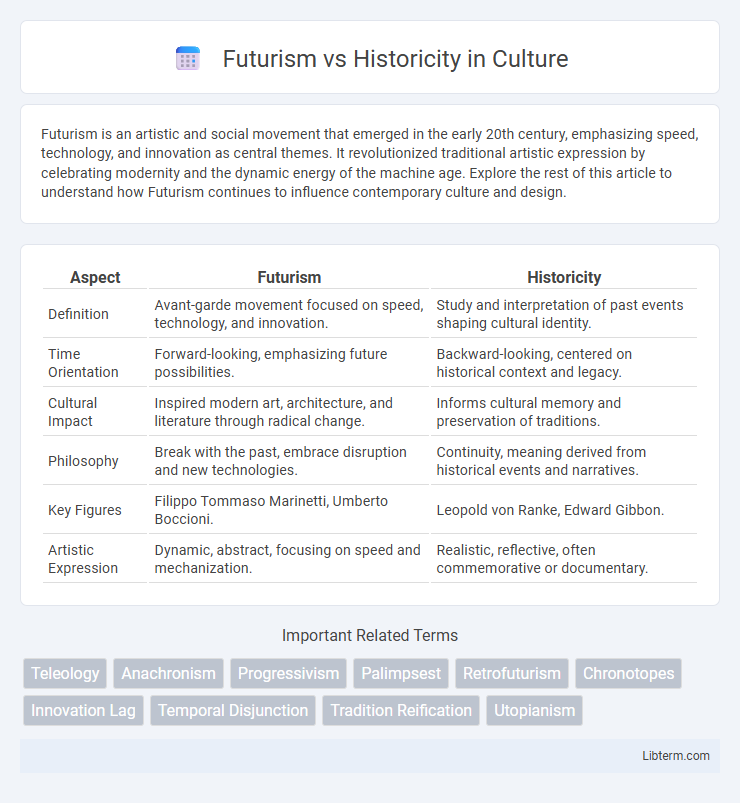Futurism is an artistic and social movement that emerged in the early 20th century, emphasizing speed, technology, and innovation as central themes. It revolutionized traditional artistic expression by celebrating modernity and the dynamic energy of the machine age. Explore the rest of this article to understand how Futurism continues to influence contemporary culture and design.
Table of Comparison
| Aspect | Futurism | Historicity |
|---|---|---|
| Definition | Avant-garde movement focused on speed, technology, and innovation. | Study and interpretation of past events shaping cultural identity. |
| Time Orientation | Forward-looking, emphasizing future possibilities. | Backward-looking, centered on historical context and legacy. |
| Cultural Impact | Inspired modern art, architecture, and literature through radical change. | Informs cultural memory and preservation of traditions. |
| Philosophy | Break with the past, embrace disruption and new technologies. | Continuity, meaning derived from historical events and narratives. |
| Key Figures | Filippo Tommaso Marinetti, Umberto Boccioni. | Leopold von Ranke, Edward Gibbon. |
| Artistic Expression | Dynamic, abstract, focusing on speed and mechanization. | Realistic, reflective, often commemorative or documentary. |
Defining Futurism and Historicity
Futurism is an artistic and cultural movement that emphasizes innovation, dynamic change, and a visionary approach toward future possibilities, often celebrating technology, speed, and modernity. Historicity refers to the authenticity and historical context of events, ideas, or artifacts, emphasizing their rootedness in specific temporal and cultural circumstances. The contrast lies in Futurism's forward-looking orientation against Historicity's focus on understanding and preserving the significance of the past.
Origins and Philosophical Foundations
Futurism emerged in the early 20th century as an avant-garde movement emphasizing speed, technology, and dynamic change, rooted in the rejection of traditional values and the embrace of modernity's transformative power. Historicity, by contrast, is grounded in the philosophical concept that historical context and temporal situatedness shape human experience and understanding, as developed in phenomenology and hermeneutics by thinkers like Heidegger and Gadamer. Futurism's origins privilege innovation and rupture with the past, whereas historicity's foundation underscores continuity, memory, and the interpretative nature of historical existence.
Key Principles of Futurism
Futurism emphasizes dynamic movement, technological innovation, and the rejection of traditional aesthetics, advocating for art and culture that reflect speed, industrial progress, and modernity. It celebrates the mechanical and urban transformation while opposing historical reverence and classical forms, promoting a break from the past to envision a radical future. The key principles include glorifying the machine age, valuing youth and change, and fostering an aggressive disruption of established norms to reshape society through creative expression.
Core Concepts of Historicity
Historicity centers on the interpretation of past events within their specific cultural, social, and temporal contexts, emphasizing the subjective nature of historical understanding. It stresses the significance of how history is constructed, acknowledging biases, narratives, and the evolving meanings attributed to historical facts. This core concept contrasts with Futurism, which prioritizes innovation and forward-looking perspectives over retrospective analysis.
Futurism in Art, Literature, and Technology
Futurism in art, literature, and technology emphasizes dynamic movement, innovation, and the rejection of traditional forms, celebrating modernity and the machine age. In visual art, Futurism manifests through fragmented forms and bold colors to represent speed and industrial progress, while in literature, it uses experimental syntax and themes of urban life and technology. Technological Futurism promotes advancements such as automation, transportation innovation, and communication technologies, prioritizing forward-thinking developments over preserving historicity or tradition.
Historicity in Cultural and Historical Analysis
Historicity in cultural and historical analysis emphasizes understanding events, ideas, and artifacts within their original temporal and social contexts to avoid anachronistic interpretations. It prioritizes the accurate reconstruction of past realities by relying on primary sources and contextual evidence, enabling a deeper comprehension of cultural meanings and historical developments. This approach contrasts with futurism, which projects current trends forward, where historicity anchors analysis in the nuanced complexities of historical specificity and continuity.
Contrasting Approaches to Progress and Change
Futurism emphasizes rapid innovation and radical transformation, prioritizing technological advancements and breaking from tradition to shape an idealized future. Historicity centers on the continuity of past experiences and context, valuing gradual evolution and lessons drawn from historical events to inform progress. This contrast highlights Futurism's forward-looking optimism against Historicity's cautious interpretation of change driven by temporal depth.
Real-World Applications and Case Studies
Futurism and historicity intersect in urban planning and technology development, where forecasting innovations depend on historical trends to predict viable outcomes. Case studies like smart city projects in Singapore demonstrate how futurism's speculative designs grounded in historical data enhance infrastructure resilience and sustainability. Practical applications in AI ethics utilize historicity to guide future algorithmic accountability, balancing innovation with social impact.
Impacts on Society and Collective Memory
Futurism reshapes society by prioritizing innovation, technology, and forward-thinking ideals that drive progress and cultural evolution. Historicity grounds collective memory in the preservation of past experiences and traditions, fostering identity and continuity across generations. The tension between these paradigms influences how communities balance change with heritage, affecting social cohesion and historical consciousness.
Future Trends: Balancing Futurism and Historicity
Balancing futurism and historicity requires integrating emerging technologies such as artificial intelligence and blockchain with the preservation of cultural heritage and historical contexts. Future trends emphasize adaptive strategies that respect historical authenticity while fostering innovation in urban planning, architecture, and education. This approach ensures sustainable development that honors past lessons and anticipates evolving societal needs.
Futurism Infographic

 libterm.com
libterm.com